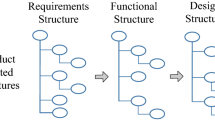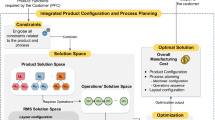Abstract
Configuration design has been recognized as an effective means to implement mass customization. Traditional configuration technologies mostly focus on practices from an engineering perspective on the basis of constraint and experience, yet leave the customer’s viewpoints intact. In this paper, a new optimization approach for customer-driven product configuration is proposed. Configuration space is firstly established as the foundation for targeting diversity of customer needs and utility function is then employed to model and measure customer preference. Subsequently, a mathematic model that maximizes the ratio between overall utility and cost from both perspectives of customers and manufacturers is formulated, and a genetic algorithm is adopted to solve the combinatory optimization problem wherein the nested encoding scheme and multiple constraints handling are incorporated to improve the performance of configuration solving. A case study of a notebook computer is reported to demonstrate that the proposed approach provides an effective means for ATO manufacturing enterprises to deliver the optimal configuration solution.
Similar content being viewed by others

References
Pine BJ (1993) Mass customization: the new frontier in business competition. Harvard Business School Press, Boston
Felfernig A, Fredrich G, Jannach D (2001) Conceptual modeling for configuration of mass customizable products. Artif Intel Eng 15(1):165–176
Jiao JX, Mitchell MT (1999) A methodology of developing product family architecture for mass customization. J Intel Manuf 10(1):3–20
Zhang JS, Wang QF, Wan L, Zhong YF (2005) Configuration-oriented product modeling and knowledge management for made-to-order manufacturing enterprises. Int J Adv Manuf Technol 25(1–2):41–52
Xie H, Henderson P, Kernahan M (2005) Modeling and solving engineering product configuration problems by constraint satisfaction. Int J Prod Res 10(1):3–20
Jiao J, Zhang Y (2005) Product portfolio planning based on customer-engineering interaction. IIE Trans 37(9):801–814
Stone RB, Wood KL, Crawford RH (2000) A heuristic method for identifying modules for product architectures. Des Study 21(1):5–31
Yu TL, Yassine AA, Goldberg DE (2003) A generic algorithm for developing modular product architectures. ASME Design Engineering Technical Conferences, Chicago, IL, V3:515–524
Erens F, Verhulst K (1997) Architectures for product families. Compute Ind 33(2–3):165–178
Jiao JX, Mitchell MT (1999) An information modeling framework for product families to support mass customization production. Ann CIRP 48(1):93–98
Du XH, Jiao JX, Mitchell MT (2003) Modeling platform-based product configuration using programmed attributed graph grammars. J Eng Des 14(2):145–167
Gonzalez-Zugasti JP, Otto KN, Baker JD (2001) Assessing value in platformed product family design. Res Eng Des - Theory Appl Concur Eng 13(1):30–41
Wang HJ, Sun BY, Zhang JM, Wang JJ, Wei XP (2005) Modular product configuration design for customer requirement-driven engineering. Chin J Mech Eng 41(4):85–91
Michalek JJ, Feinberg FM, Papalambros PY (2005) Linking marketing and engineering product design decisions via analytic target cascading. J Prod Innov Manage 22(1):42–62
Jiao JX, Zhang YY (2004) A heuristic genetic algorithm for product portfolio planning 2004 IEEE Conference on Cybernetics and Intelligent Systems, 1–3 Dec 2004, Singapore, pp 613–618
Xu ZH, Liang M (2005) Concurrent optimization of product module selection and assembly line configuration: a multi-objective approach. ASME J Manuf Sci Eng 127(11):875–884
Thurston DL, Carnahan JV (1992) Fuzzy rating and utility analysis in preliminary design evaluation with multiple attributes. Res Eng Des 3(2):105–122
Du XH, Jiao JX, Mitchell MT (2006) Understanding customer value in product customization. Int J Adv Manuf Technol DOI 10.1007/s00170-005-0177-8
Besharati B, Luo L, Azarm S (2006) Multi-objective single product robust optimization: an integrated design and marketing approach. ASME J Mech Des 128(7):884–892
Green PE, Srinivasan V (1990) Conjoint analysis in marketing: new developments with implications for research and practice. J Market 54(10):3–19
Kurapati A, Azarm S, Wu J (2002) Constraint handling improvements for multi-objective genetic algorithms. Struct Multidiscipl Optim 23(3):204–213
Balakrishnan PVS, Jacob VS (1996) Genetic algorithms for product design. Manage Sci 41(2):1105–1117
Author information
Authors and Affiliations
Corresponding author
Rights and permissions
About this article
Cite this article
Zhou, C., Lin, Z. & Liu, C. Customer-driven product configuration optimization for assemble-to-order manufacturing enterprises. Int J Adv Manuf Technol 38, 185–194 (2008). https://doi.org/10.1007/s00170-007-1089-6
Received:
Accepted:
Published:
Issue Date:
DOI: https://doi.org/10.1007/s00170-007-1089-6



